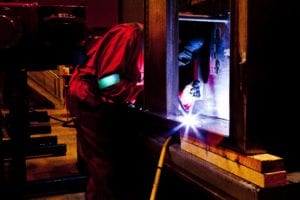Welding has been around for nearly 200 years. Since then, welders have significantly refined the materials and techniques used. One of the oldest, most versatile, and enduring methods of welding is arc welding with the use of metal rods. Learn more about the process of arc welding with rods below.
What is Arc Welding?
Shielded metal arc welding involves the use of a flux-coated welding rod to fuse two metal pieces together. As this rod melts, it becomes a part of the pieces that are being welded, creating an impenetrable bond.
The types of metals that can be joined together by welding with rods are nearly endless, as are the types of rods used to fuse these metals.

Choosing a Welding Rod
Some of the most popular types of welding rods include:
- Aluminum rods, which allow welders to arc weld aluminum with a conventional welder instead of a MIG or TIG welding machine.
- Dissimilar metal rods, which are crafted from an alloy and are specially designed to weld tempered or alloyed steels.
You can even make your own welding rod by wrapping a steel rod in cellulose (or paper) and soaking it in sodium silicate. By crimping the wrapping so that it maintains close contact with the rod, then drying the rod out in a toaster oven, a rod oven, or the sun, you’ll have a ready-to-use welding rod. As the paper wrapper burns, it will release shielding gas that provides a path for the arc.
When you’re choosing a welding rod, you’ll want to consider a few factors. First, analyze the strength properties and composition of the base metal. In many cases, the metals you’re fusing will dictate the type of rod you use. Next, consider the type of current you’ll be using to weld. Some rods are designed to be used with DC current, while others are exclusively AC. Some rods can run on both.
For details about welding with rods for your next welding project, give us a call or visit our website today.
